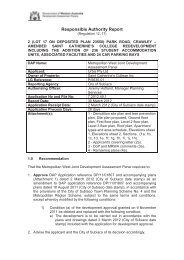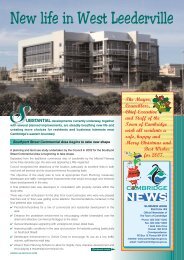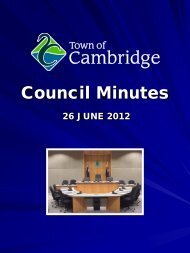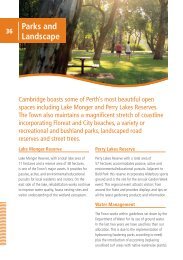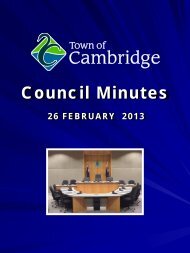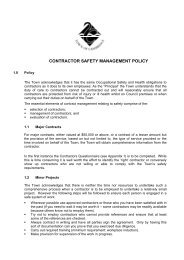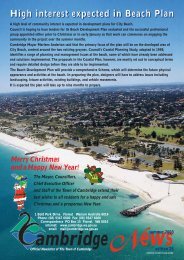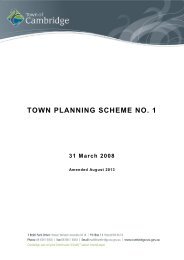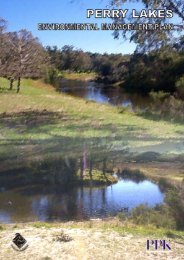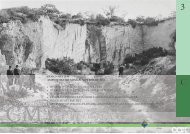Council Minutes - Town of Cambridge
Council Minutes - Town of Cambridge
Council Minutes - Town of Cambridge
You also want an ePaper? Increase the reach of your titles
YUMPU automatically turns print PDFs into web optimized ePapers that Google loves.
COUNCIL<br />
20 DECEMBER 2011<br />
PWC note that the value <strong>of</strong> the City <strong>of</strong> Stirling’s interest in the MRC is higher under Scenario A<br />
“due to the incremental value associated with the assumed acquisition and exploitation <strong>of</strong> a<br />
replacement landfill site when the existing air space at Tamala Park is exhausted”. PWC<br />
acknowledge that under this scenario, “the actual costs may be significantly different from those<br />
estimates. For this reason we consider the pro-rata values determined under Scenario B to be<br />
more robust and our preferred values”.<br />
Effectively PWC have rejected Scenario A as a basis for the valuation. The <strong>Town</strong> supports the<br />
view that Scenario A should be rejected as it highlights one <strong>of</strong> the deficiencies <strong>of</strong> the DCF<br />
method in relation to the validity <strong>of</strong> the assumptions used and the potential to significantly affect<br />
the result as identified in <strong>Town</strong>’s decision to not support the DCF method in April 2011.<br />
The <strong>Town</strong> considers Scenario A as a highly inappropriate basis to assess the valuation <strong>of</strong> MRC<br />
because it provides the owners (including Stirling) with the benefit <strong>of</strong> the positive cash flows<br />
derived from a future investment decision to purchase a landfill site after the closure <strong>of</strong> Tamala<br />
Park. At the proposed time <strong>of</strong> the capital investment it is assumed that City <strong>of</strong> Stirling will not<br />
be a member <strong>of</strong> the MRC, so how could they possibly benefit in terms <strong>of</strong> this valuation from the<br />
speculative decision <strong>of</strong> the capital purchase <strong>of</strong> an unknown site, for an unknown amount and at<br />
unknown operation and transport costs? This is a purely hypothetical scenario and should not<br />
have been considered as a reasonable way <strong>of</strong> calculating a valuation <strong>of</strong> MRC.<br />
The <strong>Town</strong> has further concerns about the assumptions used relating to the DCF valuation as it<br />
is based on the assumption that the members will sell the operations <strong>of</strong> MRC to a private<br />
operator and that the members will continue to tip at Tamala Park at a higher fee per tonne<br />
than the members currently pay so that the new owner will be able to make a return on their<br />
investment. Members currently pay a tipping fee <strong>of</strong> $123 (ex GST) per tonne and the valuation<br />
assumes that the Low valuation is based on $135 (ex GST) per tonne and the High valuation at<br />
$140 (ex GST) per tonne (refer to the table above).<br />
In reality, the market value <strong>of</strong> tipping is significantly less than this. It is understood that the City<br />
<strong>of</strong> Stirling has negotiated a fee to tip its waste at Red Hill landfill managed by the Eastern<br />
Metropolitan Regional <strong>Council</strong> at $94 (inc GST) per tonne which is $85.50 (ex GST). The City<br />
<strong>of</strong> Canning went to tender several years ago for the disposal <strong>of</strong> its waste to landfill and is<br />
currently in the third year <strong>of</strong> a contract with Sita and is also paying $94 (inc GST) per tonne.<br />
Both these disposal rates demonstrate that the market rate for tipping is much lower than the<br />
assumptions made in the PWC valuation. The fees charged by MRC are higher because <strong>of</strong><br />
their investment in a Resource Recovery Facility to divert waste from landfill which operates at<br />
a higher cost. Clearly, if members were ambivalent to resource recovery they could tip their<br />
waste direct to landfill at a much lower cost.<br />
It is difficult to accept that the members would agree to sell MRC to a private operator and then<br />
enter into contracts to pay a higher tipping cost so that the operator could make a pr<strong>of</strong>it when<br />
there are lower cost alternatives in the market.<br />
The MRC operates as a cost recovery business to keep the cost <strong>of</strong> tipping down for members.<br />
It is not operated as an investment or wealth generation facility for the members. Therefore a<br />
valuation that assumes pr<strong>of</strong>its is a flawed approach to valuing the business operations and this<br />
is consistent with the <strong>Town</strong>’s decision in April 2011 not to support the methodology. The<br />
members do not plan to sell the operations <strong>of</strong> the MRC but to continue to dispose <strong>of</strong> waste at<br />
the site.<br />
The method used by PWC does not account for the post closure obligation <strong>of</strong> the owners <strong>of</strong><br />
MRC <strong>of</strong> the Tamala Park site such as monitoring and any possible rehabilitation <strong>of</strong> the site that<br />
are unknown at his stage. Any agreement for the City <strong>of</strong> Stirling to withdraw should be<br />
conditional upon them retaining their post closure liabilities for the Tamala Park landfill in<br />
proportion to the tonnes tipped to the total <strong>of</strong> members’ tonnes over the life <strong>of</strong> the landfill.<br />
H:\Ceo\Gov\<strong>Council</strong> <strong>Minutes</strong>\11 MINUTES\December 2011\D Item 10 Onwards.docx 231



